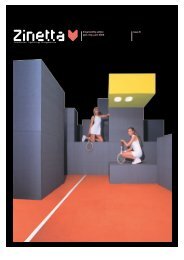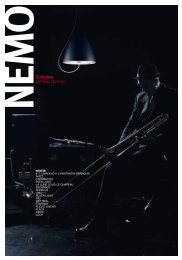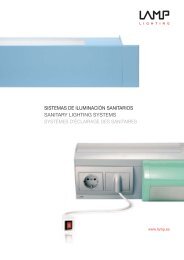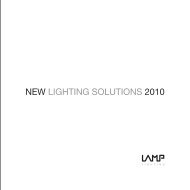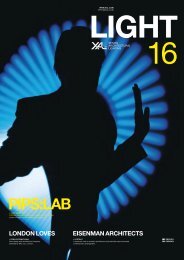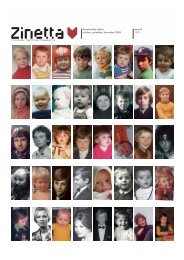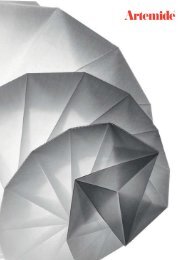Dossier 2008 © - Teclux
Dossier 2008 © - Teclux
Dossier 2008 © - Teclux
You also want an ePaper? Increase the reach of your titles
YUMPU automatically turns print PDFs into web optimized ePapers that Google loves.
History<br />
Few companies can claim to have illuminated<br />
the story of Spanish design since the times when<br />
125-volt lamps were in use. Decorative ideas have<br />
changed enormously since then, and Metalarte,<br />
born in metalwork shop, has always been there,<br />
steered by creativity.<br />
The history of Metalarte is the history of a family<br />
firm. Its origins go back to Construcciones Riera,<br />
a company founded by Antonio Riera Clariana<br />
when, in 1932, he decided to establish a metalwork<br />
shop to make the iron pieces needed by the<br />
building firm. In those days metalworkers could<br />
show off their creations on buildings fronts.<br />
They had not yet been forced into retirement<br />
by aluminium carpentry and they were considered<br />
“metal artist” by the applied arts guild. And so<br />
they were. That is why the Riera family called their<br />
first workshop Metalls Artes.<br />
Managed by Antonio Riera, the company ceased<br />
to work only on commission, launching its own<br />
lines of doorknobs, household utensils and stylish<br />
lamps. The first was produced in 1942 and<br />
was baptised, logically enough, as nº1, because<br />
in those days lamps were still not considered<br />
designer objects, nor were they given names.<br />
At that time, Spain was little more than a wasteland,<br />
and the world was at war. Then came the<br />
post-war period, and it was not until the mid-1950’s<br />
that Antonio Riera began to travel to the Nordic<br />
countries, attracted by the siren calls of burgeoning<br />
Scandinavian design. There he found inspiration<br />
for the new collections that Metal Artes launched<br />
onto the market between 1954-1960, illustrated<br />
by a first catalogue of hand-coloured photos.<br />
They were a success those were boom years.<br />
The company became firmly established and began<br />
to be seen as a reference point in the lighting<br />
industry. The company also changed its name once<br />
more, introducing Metalarte and a corporative<br />
image, something quite normal nowadays, but<br />
a distinctly odd-sounding idea in those times.<br />
Antonio Riera wanted to take his company into<br />
the future and even then he was aware that this<br />
meant taking the path of design.<br />
Until then, the lamps from Metal Artes had no<br />
recognised designer, as they were not yet signed.<br />
It is suffice to take a look, however, at the 1959<br />
and 1962 models to see the amazing resemblance<br />
these lamps have with others that can be seen<br />
today in other company showrooms. In fashion,<br />
what goes around comes around. These days, we<br />
seek inspiration in the past, whilst in those bygone<br />
days, when Spain was just starting to shake itself<br />
out of its lethargy; businesses found their inspiration<br />
in Europe, particularly in Italy. Antonio Riera<br />
went a little further, to the United States. More than<br />
inspiration, he was looking for inspired people,<br />
and in New York he found George W. Hansen an<br />
American of Danish origin who, whilst serving<br />
in the army on the Island of Labrador, designed<br />
a lamp that would later become the Swing Arm.<br />
Hansen was the catalyst for Metalarte selling<br />
lamps abroad.<br />
This American-style lamp is still one of the firm’s<br />
biggest sellers, one of those life-long success<br />
stories that are so difficult to achieve, but not<br />
impossible if you try hard enough. With everything<br />
still to do, in those times, Metalarte produced two<br />
lines of products, one neoclassical, the other more<br />
modern in style, designed by the technical<br />
department. The company lived in the present<br />
whilst not forgetting the past.<br />
We are pioneers commissioning design.<br />
André Ricard, today one of the most prestigious<br />
Spanish designers but during the 70s he was<br />
just another promising talent. He came to Metalarte<br />
with a few drawings for a lamp under his arm.<br />
It did not look like a lamp. It was small, with a<br />
twisted shape, supported by three brightly-coloured<br />
ABS arms that gave it a pop look very much in line<br />
with the times. We need to imagine the scene;<br />
what now appears as a regular meeting between<br />
a manufacturer and a designer was, in those days,<br />
a veritable act of faith. Riera’s courage did not<br />
fail him, though, and in 1970 he launched Ricard’s<br />
lamp on the market, the work of one that we<br />
would now call an emerging or up-and-coming<br />
designer. Both Antonio Riera and his brother<br />
Carlos are the kind of people who do not see<br />
business as merely profit and loss, but are capable<br />
of braving unknown territory to put good ideas<br />
into practice. Carlos Riera already knew what it<br />
was like to win a National Design Prize.<br />
He received one during his time in charge of<br />
Disform, also for his pioneering courage.


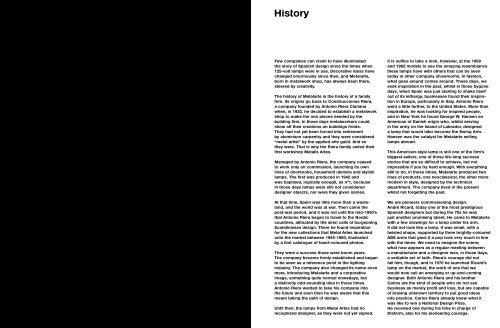

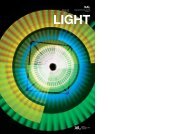

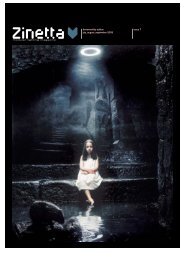

![Lataa tästä Building06 nettikirje [PDF] [591.72 KB] - Teclux](https://img.yumpu.com/41499677/1/184x260/lataa-tasta-building06-nettikirje-pdf-59172-kb-teclux.jpg?quality=85)
